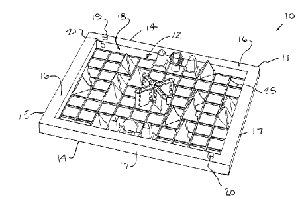 Innovention Toys, LLC v. MGA Entm’t, Inc., Dkt. No. 2010-1290 (Fed. Cir. March 21, 2011) [PDF].
Innovention Toys, LLC v. MGA Entm’t, Inc., Dkt. No. 2010-1290 (Fed. Cir. March 21, 2011) [PDF].
Innovation sued MGA, Wal-Mart, and Toys “R” Us (collectively, MGA) for infringement of Innovation’s U.S. Patent No. 7,264,242. The ‘242 patent is directed to a light-reflecting physical board game. MGA’s accused game is Laser Battle, a physical board game for playing a chess-like strategy game. One issue on appeal was whether certain prior art articles regarding chess-like computer games were analogous art for determining whether the claims directed to a physical board game of the ‘242 patent were invalid as obvious. The district court found the articles were non-analogous art. The appeals court disagreed and vacated with remand.
The ‘242 Patent. The ‘242 patent discloses a game that includes “a chess-styled playing surface, laser sources positioned to project light beams over the playing surface when ‘fired,’ mirrored and non-mirrored playing pieces used to direct the lasers’ beams, and non-mirrored ‘key playing pieces’ equivalent to the king pieces in chess.” Slip op at 2. Representative claim 31 of the patent provides:
A board game for two opposing players or teams of players comprising:
a game board, movable playing pieces having at least one mirrored surface, movable key playing pieces having no mirrored surfaces, and a laser source,
wherein alternate turns are taken to move playing pieces for the purpose of deflecting laser beams, so as to illuminate the key playing piece of the opponent.
Prior Art At Issue. The prior art at issue included articles on Laser Chess and Advanced Laser Chess published in Compute! Both articles disclosed “chess-like computer games with virtual lasers and mirrored and non-mirrored pieces which are moved or rotted by players during alternating turns on a virtual, chess-like playing board.” Slip Op. at 4.
Analogous Art and Non-Analogous Art. A reference is prior art for the purposes of determining whether an invention is obvious if it is analogous to the claimed invention. Slip op at 12. The appeals court stated, “Two separate tests define the scope of analogous art: (1) whether the art is from the same field of endeavor, regardless of the problem addressed, and (2) if the reference is not within the field of the inventor’s endeavor, whether the reference still is reasonably pertinent to the particular problem with which the inventor is involved.” Id. at 12-13. It further provided, “A reference is reasonably pertinent if . . . it is one which, because of the matter with which it deals, logically would have commended itself to an inventor’s attention in considering his problem.” Id. at 13.
Argument. Innovation argued that Compute! articles were non-analogous art because the invention dealt with a non-virtual, 3-D, laser-based board game. Innovation argued the invention involved mechanical engineering and not computer programming.
Court’s ruling. The appeals court rejected this view finding the the district court erred in holding the Compute! articles on a electronic, laser based strategy game were non-analogous because even if the Compute! articles were not in the same field of endeavor, they were reasonably pertinent to the problem facing the inventors of a new physical laser based strategy game. The court said that, “the ’242 patent and the Laser Chess references are directed to the same purpose: detailing the specific game elements comprising a chess-like, laser-based strategy game.” As a result, the case was remanded to the district court to consider the Compute! articles in addressing MGA’s claim that the patent was invalid as obvious.